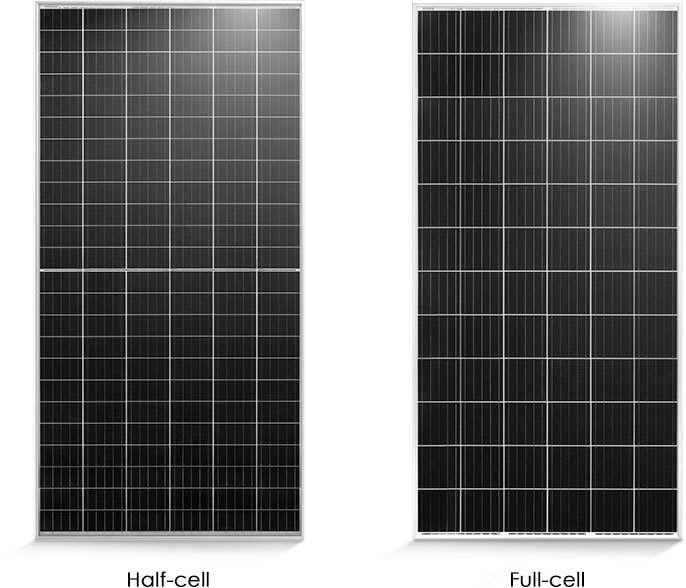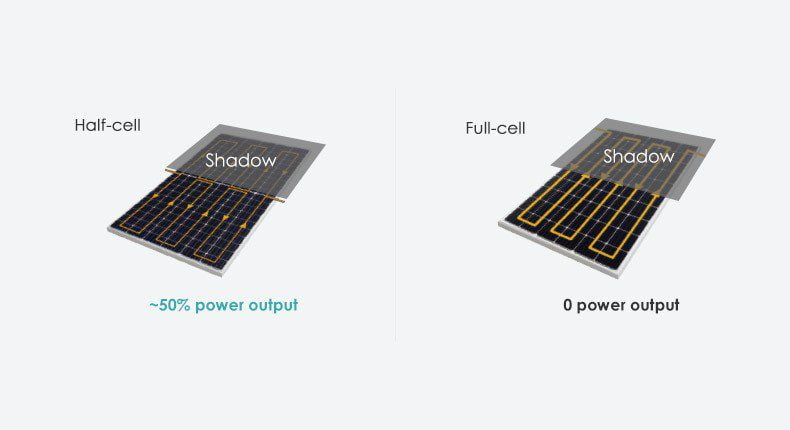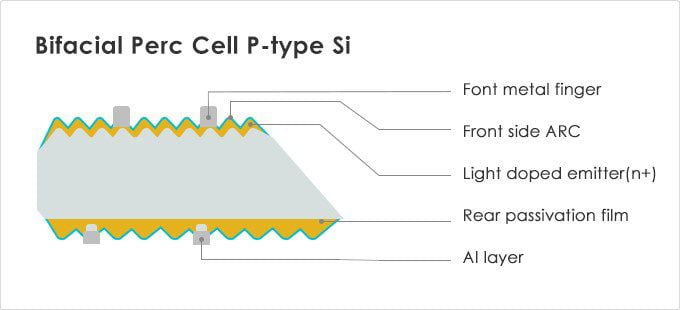How Jinko Solar Panels Technologies Can Open Up the Future of Solar Energy
Are you ready for cutting-edge solar technology to power your whole world? Explore the world of Jinko Solar, where new ideas and smart use of resources are coming together to change the way we use the sun’s energy.
Half-Cell Technology: Maximizing Efficiency and Minimizing Losses
Imagine a solar panel that works better even when it’s partly in the shade. The Half-Cell Technology from Jinko Solar gives you that power. This new technology cuts solar cells in half, which cuts internal losses by a factor of four, making the technology more efficient and effective in all situations.
- Cell Size: 182 mm x 182 mm
- Panel Efficiency: Up to 22.84%
- Size: 2278 mm x 1134 mm x 30 mm
- Weight: 31 kg
Good things:
- Better Response to Shade: Ensures higher yields in shaded situations.
- Low Operating Temperature: Works two degrees cooler than regular panels.
- Lessened Internal Losses: When the electrical current is cut in half, losses are cut by a quarter.

Using Bifacial Technology to Get Light from Every Direction
With Jinko Solar’s Bifacial Technology, panels can get sunlight from both the front and back, which greatly increases their energy output. These panels are a big deal in the world of solar energy because they gain up to 20% more power.
- Power Gain: Up to 20%, based on albedo and PV system design
- Module Efficiency: Up to 22.84%
Real Gain in Energy Production:
The Jinko plant is in Haining, which is 30.3° N / 120.4° E. The tilt angle is fixed at 30°, which is close to the latitude. The array is 1.2 metres high and can handle 1.5kW of power.

The Newest Products from Jinko Solar Panels (May 2024 Update)
As a major player in the global solar business, Jinko Solar has a wide range of solar panels to meet a wide range of needs. Here is a list of their newest products:
The Jinko Tiger Series: Power and Efficiency
People still like the Jinko Tiger Series for installing solar panels on the roofs of homes and businesses. Here are some of the newest things they have:
- Jinko Tiger Pro 72HC Mono Facial Module: This line uses half-cut cell technology, which makes it more efficient and increases the power output. You can expect wattage ratings above 570W, possibly hitting 580W to 590W.
- Jinko Tiger Pro 72HC Bifacial Module: This high-tech version has a bifacial design that lets light in from both sides. This can lead to even more power being made, especially in open spaces with shiny surfaces like snow or light-colored gravel.
The Jinko Swan Series: A Cost-Effective Option
The Jinko Swan Series is a great choice for people who want to save money without sacrificing quality. You might not be able to easily find exact wattage ratings online, but they are usually in the lower range, between 300W and 400W.
Jinko Beyond Swans and Tigers: Exploring Other Series
Jinko has more series to meet the needs of different applications:
- Jinko Eagle Series: High-efficiency monocrystalline panels that work well in utility-scale solar farms.
- Jinko Black Series: All-black panels, great for people who want their rooftop solar systems to look sleek and modern.


Beyond Jinko: Other Trustworthy Brands
Even though Jinko is a well-known company, here are some other well-known solar panel makers to check out:
- JA Solar
- Canadian Solar
- Longi Solar
- Trina Solar
Pros of Jinko Solar Panels
- Better Energy Production: Bidirectional units with a clear backsheet can get up to 20% more power gain.
- Better Durability: Using bifacial modules makes the solar panels last longer and be more durable overall.
- Better Response to Shade: The half-cell design makes it easier for plants to handle shade, which means they produce more when they are partly shaded.
- Low Working Temperature: When used in the same settings, Jinko Solar half-cell modules work at temperatures about 2 degrees lower than regular modules.
- Lessens Internal Losses: Each busbar’s electrical current is cut in half, so internal losses are only a quarter of what they are in a full-sized cell module.
The Reason You Need Solar Panels: Making Use of the Sun’s Power
Want to save a lot of money on your energy bills and help the environment at the same time? Imagine using the sun’s energy to power your home or business. You’d cut down on your carbon footprint and save a lot of money at the same time. Are you interested in making clean, green energy right from your roof? Solar panels aren’t just a trend; they’re a smart, eco-friendly choice that will pay off in the long run. Learn how solar energy can change the way you use energy, raise the value of your home, help the environment, and give you reliable power day and night by reading this piece further.
1. Cost Savings:
Putting money into solar panels will save you money on your energy bills over time. If you get your power from the sun, you don’t have to rely on the grid as much, especially during high usage times. Over time, the money saved on lower energy bills will cover the cost of installing the solar panels. In some places, there are also programmes called “net metering” that let you get points for the extra energy your solar system makes, which can help you save even more money.
2. Environmental Benefits:
Solar energy is a clean, renewable source of energy that doesn’t pollute the air or release greenhouse gases when it’s used to make power. By using solar panels, you help slow down climate change and clean up the air, which is good for both the health of the local area and the health of the planet as a whole. Using renewable energy sources like solar power is in line with eco-friendly life and helps create a cleaner, greener future for future generations.
3. Energy Independence:
Solar panels can help you become energy independent because they produce power on-site, so you don’t have to rely on energy from other sources. This independence is especially helpful when the power goes out or the grid supply is interrupted, making sure that homes and businesses can still get the energy they need. Using energy storage devices like batteries, you can save extra solar energy for times when it’s not sunny, making your energy independence even greater.
4. Government Incentives:
Different levels of government offer rewards and rebates to get people to use solar energy. Tax credits, grants, rebates, or low-interest loans may be some of these benefits for installing solar panels. Federal programmes like the Investment Tax Credit (ITC) offer big tax breaks for installing solar panels at home or in a business, which lowers the initial costs. Incentives from states and cities work with government programmes to make solar panels easier for people to get and cheaper for them to buy.
5. Increasing Home Value:
Modern solar panels are made to last and don’t need much upkeep. Regular jobs like cleaning off panels and checking electrical connections make sure they work at their best. Solar panels last a long time because they don’t have any working parts. They usually last 25 years or more. Manufacturers often offer contracts that cover how well the panels work. This gives users peace of mind and guarantees that the panels will keep producing energy for a long time.
6. Low Maintenance and Longevity:
Solar panels don’t need much care; the only thing that needs to be done is cleaning them every so often. These days, solar panels are made to last for many years, and many companies offer guarantees of 25 years or more. Once it’s set up, clean energy will work for years with little trouble.
7. Benefits for Sustainability:
Solar energy is an important part of sustainable development because it helps fight climate change and lower our reliance on fossil fuels. Solar panels help make clean energy, protect natural resources, and reduce carbon emissions by using sunlight to make power. Supporting green energy sources like solar power helps make the future of energy more stable and long-lasting for people all over the world.
8. Energy Storage Solutions:
There are many good things about energy storage solutions, like batteries and solar panels working together. They let you store extra solar energy that you make when it’s sunny so that you can use it later, at night, or on cloudy days, making sure you always have power. Battery storage systems also provide backup power when the power goes out, which makes homes and companies more energy resilient and reliable. As battery technology keeps getting better, their storage volume and efficiency keep going up. This makes them an important part of solar energy systems.
9. Benefits for the Community and the Grid:
Solar panels are good for individuals, but they also help the community and the grid in larger ways. Distributed solar production makes centralised power grids less stressed during times of high demand, which makes the grid more stable and reliable overall. Community or utility-scale solar installations can work with standard power sources to increase the variety of energy sources available and lower transmission losses. Solar energy also helps the local economy grow and supports sustainability efforts by creating jobs in the production, installation, and maintenance industries.
In Conclusion:
Solar panels are a smart, environmentally friendly way to produce energy that has many benefits. By switching to solar power, you can save a lot of money, lower your carbon footprint, become more energy independent, and even raise the value of your home. With new energy storage options and government grants, solar power is becoming easier for everyone to get and more cost-effective. Use solar energy to start saving money, help the environment, and make sure you have power day and night. Solar energy is the key to a better future, so don’t miss out on the chance to use it.
The solar business is being changed by Jinko Solar’s cutting-edge technologies. Jinko Solar panels are the best choice for both home and business solar installations because they are more efficient, work better, and last longer. Choose Jinko Solar to take the next step in the history of solar energy. Power up in a sensible way!